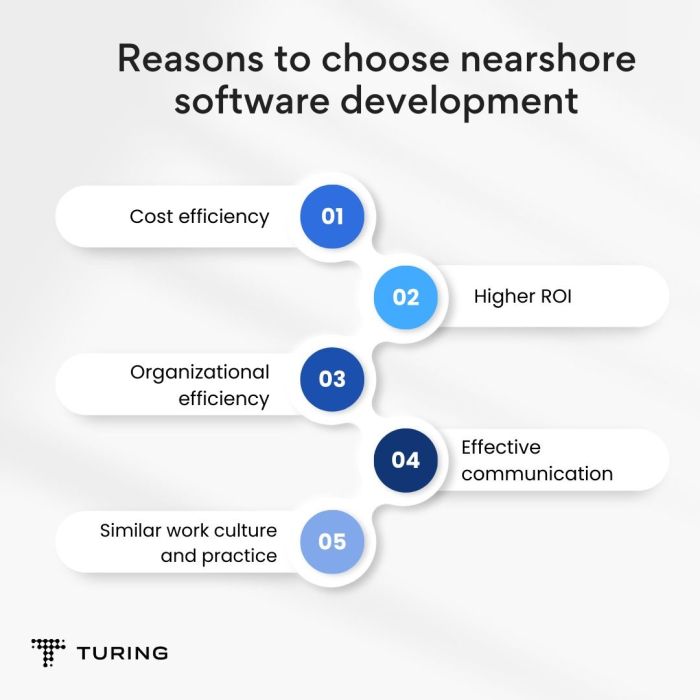The rapid expansion of cloud computing has created an unprecedented demand for skilled software developers. Businesses of all sizes are migrating their operations to the cloud, necessitating the development and maintenance of robust, scalable, and secure cloud-based applications. This has led to a surge in the popularity of nearshore software development, offering a compelling alternative to traditional outsourcing models. This detailed guide explores the intricacies of nearshore software development specifically tailored for cloud computing, covering its advantages, challenges, and best practices.
What is Nearshore Software Development?
Nearshore software development involves outsourcing software development projects to a country geographically closer than offshore locations. Unlike offshore outsourcing, which often involves significant time zone differences and cultural barriers, nearshore development leverages the proximity of the development team to the client’s location. This proximity translates to improved communication, easier collaboration, and reduced logistical complexities. For cloud computing projects, this advantage is particularly significant due to the need for frequent communication and rapid iteration cycles.

Choosing the Right Nearshore Location for Cloud Computing Projects
Selecting the ideal nearshore location is crucial. Factors to consider include:
- Time Zone Alignment: Minimal time zone difference is paramount for seamless communication and efficient project management.
- Technical Expertise: Ensure the nearshore team possesses the necessary skills in cloud platforms (AWS, Azure, GCP), relevant programming languages (Java, Python, .NET), and DevOps practices.
- Language Proficiency: Strong English proficiency is essential for clear communication and documentation.
- Cost-Effectiveness: While proximity reduces some costs, it’s vital to compare development rates to ensure cost-effectiveness.
- Legal and Regulatory Compliance: Understand the legal and regulatory frameworks of the chosen nearshore location to ensure compliance.
- Infrastructure and Technology: Assess the availability of reliable internet connectivity and robust technological infrastructure.
Popular nearshore locations for cloud computing projects include Mexico, Canada, and countries in Central and South America. Each offers a unique blend of advantages, depending on the specific needs of the project.
Nearshore software development offers significant advantages for cloud computing projects, providing a cost-effective and geographically proximate talent pool. Data security is paramount, however, and choosing the right security measures is crucial; this often includes selecting robust solutions like those reviewed in a guide to the best disc encryption software available. Ultimately, a secure nearshore development strategy ensures the confidentiality and integrity of cloud-based applications.
Advantages of Nearshore Software Development for Cloud Computing
Nearshore development offers several key advantages for cloud computing projects:

- Improved Communication and Collaboration: Reduced time zone differences facilitate real-time communication and faster response times, crucial for agile development methodologies prevalent in cloud projects.
- Enhanced Project Management: Easier travel and face-to-face meetings simplify project management and oversight.
- Cultural Understanding: Closer proximity often leads to better cultural understanding, reducing miscommunication and improving team cohesion.
- Faster Time to Market: Efficient communication and collaboration contribute to faster development cycles and quicker product launches.
- Reduced Costs Compared to Onshore Development: While not as significantly lower as offshore options, nearshore development still offers cost savings compared to employing an in-house team.
- Access to Specialized Skills: Nearshore locations often possess a pool of talented developers specializing in cloud computing technologies.
- Easier Intellectual Property Protection: Proximity reduces the risk of intellectual property theft compared to offshore outsourcing.
Challenges of Nearshore Software Development for Cloud Computing
Despite its advantages, nearshore development also presents some challenges:
- Higher Costs Than Offshore Outsourcing: Nearshore development is generally more expensive than offshore options.
- Potential Language Barriers: Although often less pronounced than with offshore teams, language barriers can still arise.
- Finding and Managing a Reliable Nearshore Partner: Thorough due diligence is crucial to ensure the chosen partner possesses the required skills and experience.
- Cultural Differences: While often less significant than with offshore teams, cultural differences can still impact communication and collaboration.
- Data Security and Compliance: Ensuring data security and compliance with relevant regulations is critical, particularly for cloud-based projects handling sensitive information.
Best Practices for Nearshore Software Development in Cloud Computing
To maximize the benefits of nearshore development for cloud computing projects, consider these best practices:
- Clearly Define Requirements and Expectations: Develop a comprehensive project scope document outlining all requirements, deliverables, and timelines.
- Establish Clear Communication Channels: Utilize various communication tools (video conferencing, instant messaging, project management software) to maintain seamless communication.
- Regular Monitoring and Progress Reporting: Implement a robust monitoring system to track progress and address issues promptly.
- Cultural Sensitivity Training: Consider providing cultural sensitivity training to both onshore and nearshore teams to foster better understanding and collaboration.
- Secure Data Transfer and Storage: Implement robust security measures to protect sensitive data during transfer and storage.
- Choose a Reputable Nearshore Partner: Conduct thorough due diligence to select a partner with proven experience and a strong track record.
- Utilize Agile Methodologies: Agile development approaches facilitate iterative development, faster feedback loops, and greater flexibility.
Cloud Platforms and Technologies in Nearshore Development
Nearshore development teams should be proficient in various cloud platforms and technologies, including:
- Amazon Web Services (AWS): Expertise in services like EC2, S3, Lambda, and RDS is essential.
- Microsoft Azure: Proficiency in Azure Virtual Machines, Azure Storage, Azure Functions, and Azure SQL Database is crucial.
- Google Cloud Platform (GCP): Understanding of Compute Engine, Cloud Storage, Cloud Functions, and Cloud SQL is necessary.
- Containerization Technologies (Docker, Kubernetes): Experience with containerization is vital for building scalable and portable cloud applications.
- DevOps Practices: Adoption of DevOps principles (CI/CD, infrastructure as code) is essential for efficient cloud development.
Frequently Asked Questions (FAQ)
- Q: What are the key differences between nearshore and offshore software development? A: Nearshore development involves outsourcing to a geographically closer country, leading to improved communication and collaboration compared to offshore outsourcing, which often involves significant time zone differences.
- Q: Is nearshore development more expensive than offshore development? A: Yes, nearshore development is generally more expensive than offshore development but offers significant advantages in terms of communication and collaboration.
- Q: What are the best practices for managing a nearshore development team? A: Establish clear communication channels, regular monitoring, and utilize project management tools. Cultural sensitivity training can also be beneficial.
- Q: How can I ensure data security in nearshore development for cloud computing? A: Implement robust security measures, including secure data transfer protocols, encryption, and access controls. Choose a nearshore partner with strong security practices.
- Q: What are some popular nearshore locations for cloud computing projects? A: Mexico, Canada, and several countries in Central and South America are popular choices.
Conclusion
Nearshore software development offers a compelling solution for businesses seeking to leverage the benefits of cloud computing while mitigating the challenges associated with traditional outsourcing. By carefully selecting a nearshore partner, implementing best practices, and addressing potential challenges proactively, organizations can harness the power of nearshore development to build robust, scalable, and secure cloud-based applications efficiently and cost-effectively.
Call to Action
Ready to explore the potential of nearshore software development for your cloud computing projects? Contact us today for a free consultation!
